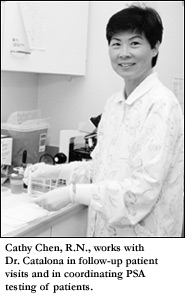Recent Prostate Cancer Studies
At a conference focused on prostate cancer treatments and cures, Dr. Catalona presented findings on recent prostate cancer studies. The following are summaries of those presentations:
 Age Has Impact on Continence After RRP
Age Has Impact on Continence After RRP
Dr. Catalona completed a study to look at the age of his patients and the percentage who were continent after a RRP.
Age did have some bearing on continence.
Under the age of 50 and up until age 59, 95% of the patients were continent after surgery.
From age 60-69, 93% regained continence and in those over 70, 85% regained continence.
Patients included in the analysis were those who had been followed for at least 18 months after surgery and did not have adjuvant radiation or hormonal therapy.
Continence usually gets as good as it is going to get by 18 months to 2 years.
Overall, 93% of patients in Dr. Catalonas series regained continence.
PSA Testing Has Effect on Survival Rates
Survival rates were compared before widespread PSA testing was common in the US and after PSA testing became commonplace.
The study showed that progression-free survival rates have increased since the use of PSA testing for diagnosis of prostate cancer.
Percentage Progression-Free Survival
(Pre-PSA testing, 1983-91) 5 Year 7 Year 10 Year 71% 66% 59%
(PSA Era, 1992-2001) 5 Year 7 Year 10 Year 83% 80% 77%
Diet Affects Risk for Prostate Cancer
A follow-up of 51,500 men in a study at Harvard showed that diet does affect the risk for prostate cancer.
Red meat and dairy products appear to be related to increased risk of metastatic prostate cancer.
Fatty fish, especially salmon, lowers prostate cancer risk. A low-fat diet appears to inhibit prostate cancer.
A high-fat diet, a diet rich in vegetable oils, appears to stimulate prostate cancer.
Needle Biopsies As Diagnostic Tool
More needle biopsies do not detect more harmless cancers. More biopsies detect more organ-confined prostate cancers without overdetecting possible harmless ones.
Maximum cancer detection results from combining both routine sextant and posterolateral needle biopsies.
Even after two sets of 10-core biopsies, 10% of cancers are missed. And 90% of those 10% missed were clinically significant, meaning they needed treatment.
The percent of needle biopsy tissue with cancer is a predictor of prostate cancer more difficult to treat. It’s a more significant predicator than PSA or Gleason score.











